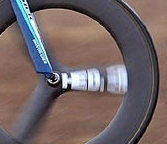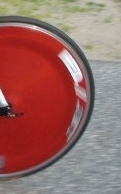Tubulars vs Clinchers, and the Most Practical Race Wheels
This is one of those debates that never dies. I use tubulars. Not because I think they are better, but because until recently I was using a HED Cx front wheel that was probably bought in 1993. Back then there was no debate – all race wheels ran tubulars. So when I  upgraded my rear wheel several years back, I got a tubular to match my front. Then I got a new front wheel, and well you get it. BUT – my next set of race wheels will be clinchers.
upgraded my rear wheel several years back, I got a tubular to match my front. Then I got a new front wheel, and well you get it. BUT – my next set of race wheels will be clinchers.
This article does a very good job of looking at both sides of this issue. To me, the main benefits of tubulars are greater puncture resistance and the ability to ride them once flat. They MAY also be faster to change when flat, but that depends on how well they’re glued and how good you are at changing clinchers. Knock on wood, I’ve never flatted in a race in 17 years – did my tubulars save me? Who knows.
BUT – tubulars’ drawbacks are many. They’re a pain to glue – and I’ve glued many over the years. They’ll potentially roll off the rim if glued improperly or if the glue dries out. And maybe the worst: Having to carry a spare tire in long races  instead of just a tube or two. It can be a real pain to figure out where to attach your spare, which by the way cost $60 or more vs a $4 tube. And that brings up the overall expense: tubulars cost a bit more, but if you flat they REALLY cost more – $60+ down the drain vs $4 (come on – no one patches tubulars anymore). So you really don’t want to train on your tubulars and risk an expensive flat. Clincher race wheels? Sure train on them if you want to – at least sometimes (I prefer to wait for race day to get that extra boost though).
instead of just a tube or two. It can be a real pain to figure out where to attach your spare, which by the way cost $60 or more vs a $4 tube. And that brings up the overall expense: tubulars cost a bit more, but if you flat they REALLY cost more – $60+ down the drain vs $4 (come on – no one patches tubulars anymore). So you really don’t want to train on your tubulars and risk an expensive flat. Clincher race wheels? Sure train on them if you want to – at least sometimes (I prefer to wait for race day to get that extra boost though).
Things that don’t matter in my opinion: weight savings, ride quality, higher pressure (tubulars are theoretically better in all). Clinchers have really closed these gaps though, and the differences just don’t really  matter in the real world. You can even get full carbon clinchers if you want to save a little weight. I personally wouldn’t pick full carbon clinchers over clincher race wheels with aluminum braking surfaces. Carbon wears down and you need special brake pads. Plus, if you do flat a carbon clincher and the tire rolls off, carbon meets asphalt which COULD do some major damage. So here again, I wouldn’t want to train on them.
matter in the real world. You can even get full carbon clinchers if you want to save a little weight. I personally wouldn’t pick full carbon clinchers over clincher race wheels with aluminum braking surfaces. Carbon wears down and you need special brake pads. Plus, if you do flat a carbon clincher and the tire rolls off, carbon meets asphalt which COULD do some major damage. So here again, I wouldn’t want to train on them.
So the most practical race wheels then are aluminum-rim clinchers. You can get anything from a disc to a semi-deep carbon rim to a tri-spoke in this configuration. You can run your training wheel in the back with a disc cover, and any number of race wheels in the front (which you probably wouldn’t do if your front race wheel was a tubular). And you’ll never need to know the joy of having tubular cement stuck to your fingers for days.

August 25, 2009 @ 1:20 pm
You make some great points, TK. I have to admit,I am old school when it comes to tubies for racing!
What about flat resistance? I’ve always felt (having experienced it!), that the greatest risk of flatting on race day with clinchers comes from a pinch flat. No risk of this with tubies. And, if you glue em up right, they can be faster to change out…
In terms of cost and versatility and ease of preparation, its a no brainer. Thanks!!
August 25, 2009 @ 4:08 pm
Yes there is no doubt tubulars prevent pinch flats. But if your tires are properly inflated, this is a fairly low-probability event – in maybe 20 years of training and racing, I may have had 1 or 2 pinch flats – and I’m heavy…
September 26, 2009 @ 5:53 pm
Hi TK, you made the point here. Just forgot one important point. The tubular also have received alot of attention from manufacturer, and got nice evolution. We sell huge quantity of carbon rims, and guess what ?
1. I always recommend full carbon clincher version wheels to newbies
2. What do I use for training ? Ans.: clincher
3. What do I use for race ? Ans.: clincher